I have never had a wildflower meadow but have always enjoyed fields of wildflowers. Now that I have a little bit of space on our new land I have begun the process of starting my own wildflower meadow/garden. It is a process, as I am quickly learning.
A wildflower garden is not so simple as throwing out some seeds and hoping for the best as I have learned through researching wildflower meadows online. American Meadows has a wonderful website and people who are more than happy to help out new wildflower enthusiasts like myself. They have been wonderful with explaining the process of seeding a wildflower meadow but for me I guess it was all still a bit overwhelming. Part of the problem is that wildflower meadows take years to develop fully and while they are lower maintenance than lawns and gardens, there is still a lot of maintenance to be done if one wishes to be successful. So I am doing my new wildflower meadow my way.
Basically I have gathered that you should: kill all weeds and grasses ahead of time (two doses of glyphosate did that), don't overly disturb the soil because you will stir up dormant weed seeds (lightly raked the soil), seed specific seeds after the first couple of hard freezes (if erosion will not wash away the seeds in the winter), or early enough that the seedlings can get established before a freeze, or in late winter/early spring (I have not decided on which option I will use), mow and treat weeds as they grow but make sure you don't mow down your new wildflowers, burn the area after a few years, keep out woody weeds, and basically manage your wildflower meadow rather scientifically-forever. If you do this you will get a beautiful wildflower meadow out of the process. Well, that remains to be seen in my case because I am in the very early stages of my wildflower planting experiment. And here is the experiment or the 'my way' part of managing my wildflower meadow.
Instead of relying only on seeds to start the wildflower meadow I decided that since I was moving flowers from my current garden (Tiger Gardens) to the new garden (Tiger Way Gardens) that perhaps I could kind of start with an instant meadow by moving plants instead of relying only on seeds?
My first step was to choose all of the appropriate plants in my garden I thought might be appropriate for the conditions in my wildflower meadow area. The plants had to not only grow in the conditions (full sun, heavy clay, acidic soil, waterlogged at times), but they had to be native plants (or naturalized) that would care for themselves and not take a lot of work from me to maintain. My goal is to have a wide diversity of plants that will provide a little ecosystem that will attract not only pollinators such as bees and butterflies, but also migrating and year round resident birds. I also want color throughout most of the year but mainly in the summer, even tho I tried to chose plants for year round interest. I realized that given these conditions, I had many appropriate wildflowers already growing in my nicely manicured gardens that could make the move to 'the wild side of a meadow garden'. Bingo! I now had a location to move the plants to and geez, I didn't even have to prepare a garden (but I did kill the currentvegetation weeds growing there and I have lightly prepared the area for seeds in a few months or so. So today's post is to showcase the few wildflowers I have already successfully moved from Tiger Gardens to Tiger Way Gardens. Almost all of the plants I transplanted have succeeded in growing wonderfully. These plants are almost all native (or naturalized) to the United States, and will spread themselves around and provide year round interest. I planted them fairly randomly but in drifts that I hope will form colonies over time. We shall see how that goes. According to American Meadows the advantage of planting with seed is that the seed sowing process arranges seeds in a random manner; which is good for wildflower gardens. We want these kinds of gardens to look like nature planted them. The plants I show here are not the only plants for the wildflower garden as I did order seed as well, plus there are a few other perennials I transplanted that I did not get photos of. They include: balloon flower and baptisia. Additionally, as I dug these plants from my current garden I was able to split and divide most all of them. There are several of the following plants growing in the wildflower meadow but I only show one picture per plant here. I will share the seeding part of the process when the time comes. I spent a lot of time choosing the appropriate seeds for my wildflower meadow and hope I made the right choices! At any rate, I know I did good on these plants so without further ado they are....
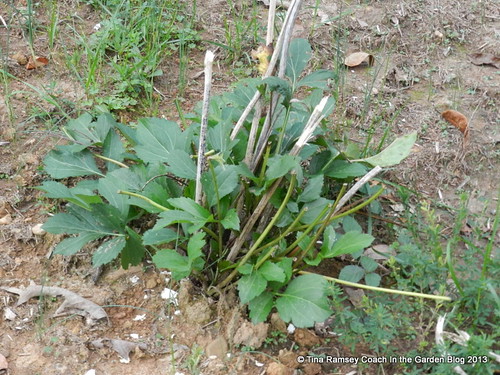
Rudbeckia lacinata, aka Cutleaf Coneflower

Tatarian Asters, browsed by the deer-darn it!
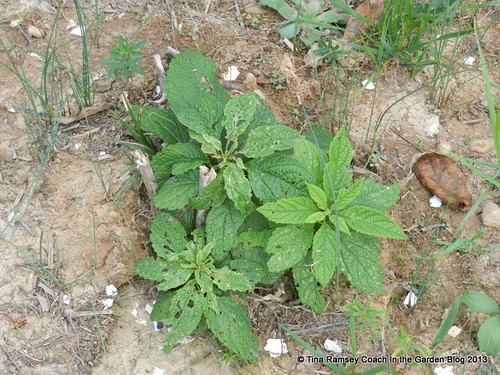
Joe Pye Weed.
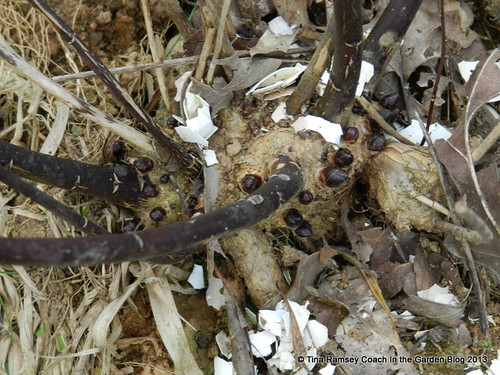
Amsonia hubrichtii, look at all of those buds!
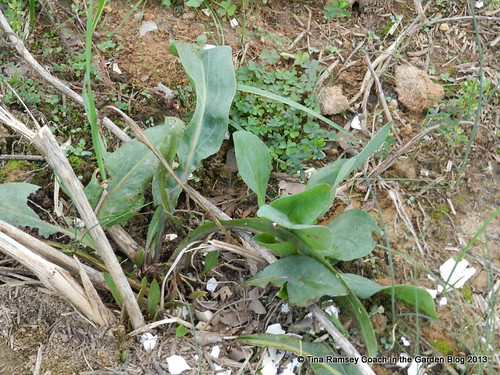
Rudbeckia maxima, aka Giant Coneflower.

Rudbeckia triloba.
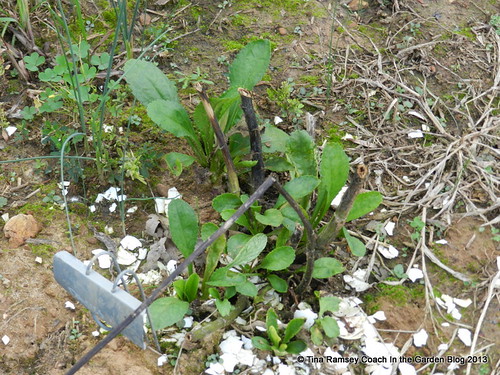
Chrysanthemum x superbum, aka Shasta daisies.
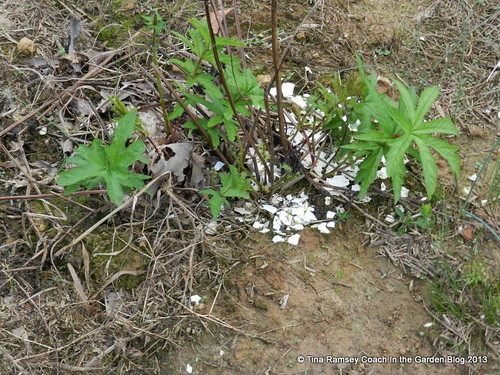
Filapendula rubra, aka Queen of the Prairie.
I placed crushed eggshells around all of the newly planted wildflowers so that I would be able to distinguish them from the weeds (there are still many that I have to battle). You may notice the eggshells in some of the above pictures. I don't plan to fertilize this area but will most likely burn it in a few years and do other maintenance as necessary....
in the garden....
Words and Photos Property of In the Garden Blog Team, In the Garden
A wildflower garden is not so simple as throwing out some seeds and hoping for the best as I have learned through researching wildflower meadows online. American Meadows has a wonderful website and people who are more than happy to help out new wildflower enthusiasts like myself. They have been wonderful with explaining the process of seeding a wildflower meadow but for me I guess it was all still a bit overwhelming. Part of the problem is that wildflower meadows take years to develop fully and while they are lower maintenance than lawns and gardens, there is still a lot of maintenance to be done if one wishes to be successful. So I am doing my new wildflower meadow my way.
Basically I have gathered that you should: kill all weeds and grasses ahead of time (two doses of glyphosate did that), don't overly disturb the soil because you will stir up dormant weed seeds (lightly raked the soil), seed specific seeds after the first couple of hard freezes (if erosion will not wash away the seeds in the winter), or early enough that the seedlings can get established before a freeze, or in late winter/early spring (I have not decided on which option I will use), mow and treat weeds as they grow but make sure you don't mow down your new wildflowers, burn the area after a few years, keep out woody weeds, and basically manage your wildflower meadow rather scientifically-forever. If you do this you will get a beautiful wildflower meadow out of the process. Well, that remains to be seen in my case because I am in the very early stages of my wildflower planting experiment. And here is the experiment or the 'my way' part of managing my wildflower meadow.
Instead of relying only on seeds to start the wildflower meadow I decided that since I was moving flowers from my current garden (Tiger Gardens) to the new garden (Tiger Way Gardens) that perhaps I could kind of start with an instant meadow by moving plants instead of relying only on seeds?
My first step was to choose all of the appropriate plants in my garden I thought might be appropriate for the conditions in my wildflower meadow area. The plants had to not only grow in the conditions (full sun, heavy clay, acidic soil, waterlogged at times), but they had to be native plants (or naturalized) that would care for themselves and not take a lot of work from me to maintain. My goal is to have a wide diversity of plants that will provide a little ecosystem that will attract not only pollinators such as bees and butterflies, but also migrating and year round resident birds. I also want color throughout most of the year but mainly in the summer, even tho I tried to chose plants for year round interest. I realized that given these conditions, I had many appropriate wildflowers already growing in my nicely manicured gardens that could make the move to 'the wild side of a meadow garden'. Bingo! I now had a location to move the plants to and geez, I didn't even have to prepare a garden (but I did kill the current

Rudbeckia lacinata, aka Cutleaf Coneflower

Tatarian Asters, browsed by the deer-darn it!

Joe Pye Weed.

Amsonia hubrichtii, look at all of those buds!

Rudbeckia maxima, aka Giant Coneflower.

Rudbeckia triloba.

Chrysanthemum x superbum, aka Shasta daisies.

Filapendula rubra, aka Queen of the Prairie.
I placed crushed eggshells around all of the newly planted wildflowers so that I would be able to distinguish them from the weeds (there are still many that I have to battle). You may notice the eggshells in some of the above pictures. I don't plan to fertilize this area but will most likely burn it in a few years and do other maintenance as necessary....
in the garden....
A lot of work. It will be so satisfying when it all begins to bloom.
ReplyDeleteI have been trying to get a meadow going on our drain field. I don't feel comfortable burning...we don't have water up there and no fire hydrants. I like American Meadows, bought a lot of seeds that I have scattered over the years. Some have shown up and some....the blackberry brambles have taken over. My approach will be cutting (bush hogging) about every 6-8 weeks, once after our first hard frost, once late May/ early June, and again mid July.
ReplyDeleteIt sure will look gorgeous. Glad you are having a meadow.
ReplyDeleteGlad you're having such success with the transplants. Great idea on the egg shells which will eventually go away. Can't wait to see the blooms.
ReplyDeleteI love it. I think you've got the basic and a good start. My property is mostly oak woods so that what I go with for my wildflower garden. I do have a small south facing open area which I'm converting from weeds to natural prairie. This has been mostly seeded. I've used Prairie Moon seeds here in Minnesota. They have a website and excellent catalogue...:)
ReplyDeleteYour going to have such fabulous gardens. I'm enjoying your journey, though I don't always comment.
ReplyDeletecant wait to see
ReplyDeleteOh, Tina, I am so envious! A meadow of wildflowers has always been a dream of mine. I do have the space, but my problem is finding the time and energy to establish one. I've done a little reading on it, and yes, it isn't as easy as just throwing out seed and hoping for the best. The weeds can overtake a wildflower garden just as easily as any other type of garden, and I find distinguishing between the weeds and wildflower seedlings is often difficult. Your idea of sprinkling eggshells around your new plantings is a great idea, and one I might copy. Great choices for transplanting--gosh, this is going to be beautiful!
ReplyDeleteA meadow of wild flowers. What a visual treat! :-)
ReplyDeleteGreetings from London.
Sounds like a lot of work and yes, just tossing out seed does not work as I have been doing that for years with little results. Grrrr. Cant wait to see your Wildflower Meadow!
ReplyDeleteYou will love it and it is worth the work.
ReplyDelete